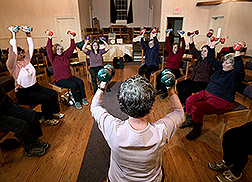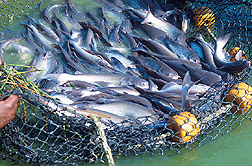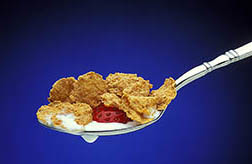| July 2005 |
Cocoa-Rich Products: A Good Antioxidant Buy
Cocoa powder contains more beneficial antioxidants than several other popular chocolate products made from cocoa beans, ARS analyses have shown. A study funded in part by the American Cocoa Research Institute, using samples provided by manufacturers, also showed processing of the beans lowers antioxidant content.
ARS scientists at the Arkansas Children's Nutrition Center and the Beltsville (Md.) Human Nutrition Research Center scrutinized what's known as the total antioxidant capacity, and the levels of procyanidins—the cocoa bean's most prevalent antioxidants—in natural unsweetened cocoa powders, Dutch-processed cocoa powders, unsweetened baking chocolate, semisweet chocolate baking chips, dark chocolates and milk chocolates.
Why the interest in cocoa and chocolate antioxidants? Changes in food processing procedures or cocoa and chocolate factory formulations might make it possible to boost the antioxidant values of tomorrow's cocoa-bean-derived beverages and confections. That would be sweet news indeed, because antioxidants are thought to help prevent cancer, heart disease and stroke.
For details, contact: Ronald L. Prior, (501) 364-2747; USDA-ARS Arkansas Children's Nutrition Center, Little Rock, Ark.
Strength Training Yields Hefty Benefits for Seniors
Elderly volunteers with osteoarthritis or kidney disease benefitted from strength training, according to two studies by researchers at the ARS Jean Mayer USDA Human Nutrition Research Center on Aging.
Seniors with osteoarthritis found that their muscle strength increased by 14 percent and balance improved by 55 percent after a 12-week strength-training program. What's more, their flexibility improved by 17 percent, and pain, based on their own evaluations, decreased by 30 percent.
Other volunteers—seniors diagnosed with chronic kidney disease—increased total muscle fiber by 32 percent and muscle strength by 30 percent after 12 weeks of strength training (American Journal of Kidney Disease, volume 43, pages 607-616).
Muscle loss, called sarcopenia, can begin in our mid-40s, with one's total amount of muscle declining at the rate of about 1 percent a year.
For details, contact: Carmen Castaneda Sceppa, (617) 556-3081; ARS Jean Mayer USDA Human Nutrition Research Center on Aging at Tufts University, Boston, Mass.
High Carbs May Boost Cataract Risk
|
|
New details about the association between high carbohydrates and cataract risk have emerged from a study reported in the June 2005 issue of the American Journal of Clinical Nutrition (volume 81, pages 1411-1416). Women who ate an average of 200 to 268 grams of carbohydrates every day were more than twice as likely to develop cortical cataracts than women whose meals provided between 101 and 185 grams by day's end. That's according to ARS-funded scientists at the ARS Jean Mayer USDA Human Nutrition Research Center on Aging at Tufts University, Boston, Mass.
The recommended daily allowance for carbs for adults and kids is 130 grams.
The researchers analyzed eye exam results and 14 years' worth of food records collected from 417 women, age 53 to 73. The women, participants in the nationwide Nurses' Health Study, did not have a history of cataracts but were recently diagnosed with the disease.
Cataracts are a major cause of blindness worldwide and afflict an estimated 20 million Americans.
Scientists don't know what links high-carb intake to increase cataract risk. One possibility is that increased exposure to glucose, a breakdown product of carbs, might damage our eyes' lenses.
For details, contact: Chung-Jung Chiu, (617) 556-3157; ARS Jean Mayer USDA Human Nutrition Research Center on Aging at Tufts University, Boston, Mass.
Vitamin E Enhances Elders' Immune Systems
Long-term nursing home residents who took 200 International Units (IU) of vitamin E daily for one year were 20 percent less likely to catch colds or other upper respiratory infections than peers who took a four-IU capsule of this essential nutrient. The federally recommended upper limit for vitamin E is 1,500 IUs a day
Because of seniors' highly vulnerable immune systems, upper respiratory infections pose a greater health threat to them than to most other age groups.
Researchers studied the weekly health reports of 617 men and women, all over age 65, who participated in the vitamin E study. The scientists, based at the ARS Jean Mayer USDA Human Nutrition Research Center on Aging at Tufts University, Boston, Mass., reported their results in a 2004 issue of the Journal of the American Medical Association (volume 292, pages 828-836).
Foods rich in vitamin E include sunflower seeds, almonds, wheat germ and leafy green vegetables.
For details, contact: Simin K. Meydani, (617) 556-3129; ARS Jean Mayer USDA Human Nutrition Research Center on Aging at Tufts University, Boston, Mass.
Coating to Keep Apple Slices Crisp, Fresh, Gains Popularity
Sliced applies, protected by an invisible, vitamin- and mineral-based coating, can keep their appealing color and texture for up to 28 days in the refrigerator, home cooks and gourmet chefs alike are discovering. The invisible coating—an easy-to-apply dip—was patented by ARS and co-investigators at Mantrose-Haeuser, Co., Inc., Westport, Conn., several years ago.
Today, marketed as NatureSeal, it's used in homes, school cafeterias, supermarket delicatessens, upscale restaurants and in fast-food restaurants nationwide. Some supermarkets sell packets of NatureSeal for home use. It's also available on the World Wide Web.
Unlike lemon juice—a traditional option for keeping apple slices from turning mushy and brown—the coating doesn't change the crisp texture and natural flavor of freshly sliced apples.
For details, contact: Dominic W.S. Wong, (510) 559-5860; USDA-ARS Western Regional Research Center, Albany, Calif.
SunButter: "Spreading" Across America
|
|
A tasty sunflower-seed butter—perfect for spreading on breads or crackers, for example—is now sold in an array of flavors and textures. Marketed as SunButter, the spread comes in creamy, natural, natural crunch, honey crunch—and even a low-carb version.
ARS scientists based in New Orleans, La., at the Southern Regional Research Center, and colleagues at Red River Commodities, a Fargo, N.D.-based sunflower seed processor, developed the spread several years ago.
The product is a satisfying option for the roughly three million Americans who suffer from peanut allergies. Twelve states now include SunButter in their school lunch programs. And, some airlines provide snacks made with SunButter, as an alternative to peanuts.
Details are in the August 2005 Journal of Food Science (volume 70, pages S365-370).
For details, contact: Isabel M. Lima, (504) 286-4515, ext. 515; USDA-ARS Southern Regional Research Center, New Orleans, La.
Fresh or Frozen, Defender Is a Good Potato
Long, white-skinned potatoes in the produce section of your supermarket might be "Defender"—the only commercially grown potato in the United States today with tubers and leaves that fend off late blight disease. Worldwide, late blight is generally regarded as one of the worst diseases of potatoes.
Besides starring as a fresh-market potato, Defender also can be processed into frozen products. ARS scientists in the Small Grains and Potato Research Unit , Aberdeen, Idaho, and the Vegetable and Forage Crop Research Unit, Prosser, Wash., worked with university colleagues to in Idaho, Oregon and Washington develop this superior spud. They put it through more than a decade of rigorous outdoor tests before making it available to growers, processors, potato-seed companies and others last year.
The plant's natural resistance to late blight allows growers to use either no fungicides—or much smaller amounts—to control the disease. This feature makes the potato ideal for conventional and organic farms alike.
For details, contact: Richard G. Novy, (208) 397-4181, ext. 111; USDA-ARS Small Grains and Potato Germplasm Research Unit, Aberdeen, Idaho.
Catfish Vaccines Boost Fish Health
Two new vaccines for channel catfish may bring better health to this popular fish. And averting disease-related losses may enhance fish farmers' balance sheets—with possible savings for you at the fresh-fish section of your supermarket.
Channel catfish rate as America's third-most-popular, domestically farmed fish.
ARS scientists in the USDA-ARS Aquatic Animal Health Research Unit, Auburn, Ala., and Chestertown, Md., developed the vaccines to protect fish against a disease known as columnaris, named for Flavobacterium columnare—the bacterium that causes it. Ranked as the second-worst disease of catfish, it also afflicts other species ranging from goldfish to largemouth bass to salmon. The microbe is harmless to humans.
The vaccines are apparently the first to contain a live, modified form of the bacteria, a feature that is generally regarded as providing more effective protection than vaccines containing killed bacteria.
An added benefit: To administer either vaccine, fish farmers only need to place the fish in a tank containing a carefully measured amount of the vaccine. That option means less stress for the fish and less cost for the producers than injecting each fish with the vaccine.
For details, contact: Phillip H. Klesius, (334) 887-3741, ext. 12; USDA-ARS Aquatic Animal Health Research Unit, Auburn, Ala.
Teamwork Keeps Milk Safe
Got safe milk? ARS food safety researchers and their colleagues in northeastern and mid-Atlantic states have teamed up to make sure the answer is always "Yes!"
The collaboration with veterinarians, university researchers and others who belong to the Regional Dairy Quality Management Alliance will, among other results, lead to a new set of "best management practices." Dairy producers in 10 states can use those guidelines to minimize the risk of diseases caused by microbes in dairy cows and dairy products
ARS scientists in Beltsville, Md., and Athens, Ga.—and their co-investigators—are analyzing dairy manure samples, bird droppings and water, for instance, from test farms in New York, Pennsylvania and Vermont to check for such pathogens as Salmonella, E. coli, Listeria and Campylobacter.
An example: Samples from one farm showed that although 45 percent of the cows tested positive for Salmonella, milk from the animals was free of detectable levels of the microbe.
For details, contact: Jeffrey S. Karns, (301) 504-6493, ext. 346; USDA-ARS Henry A. Wallace Beltsville Agricultural Research Center, Beltsville, Md.
Zinc: Does It Fight Prostate Cancer?
|
|
For decades, scientists have known that zinc may play a role in keeping the prostate gland healthy. Now, studies at the ARS Western Human Nutrition Research Center, Davis, Calif., are revealing new details about how zinc might help fight cancer of the prostate—the second-most common cause of cancer-related deaths among American men.
Laboratory investigations using cancerous and cancer-free human prostate cells indicated that the cancerous cells accumulated less zinc than the healthy ones. That might be explained by another of the team's findings: The cancerous cells had lower levels of ZIP1, a protein that specializes in moving zinc through the membrane that encloses a cell. Although another zinc-ferrying-protein, ZIP3, was present in the cancer cells, it wasn't in the right location to be its most effective.
ARS and the National Institutes of Health are funding the research.
For details, contact: Liping Huang, (530) 754-5756; USDA-ARS Western Human Nutrition Research Center, Davis, Calif.
Iron's Safety: Taking a Closer Look
Iron-fortified foods such as breakfast cereals don't pose a special health risk to most people. That includes the one out of every 10 Americans who has one normal and one altered form of a gene linked to iron overload.
Men and women volunteers with that genetic makeup did not absorb significantly more iron from their foods in comparison to volunteers with two normal genes for iron absorption, researchers have found.
Scientists at the ARS Grand Forks (N.D.) Human Nutrition Research Center worked with data from volunteers—100 healthy men and women in this study—and presented their findings in a 2004 issue of the American Journal of Clinical Nutrition (volume 80, pages 924-931).
Certain foods are iron-fortified to ensure that we get the recommended daily amount of this essential mineral.
For details, contact: Janet R. Hunt, (701) 795-8328; USDA-ARS Grand Forks Human Nutrition Research Center, Grand Forks, N.D.
Copper and You: How Much Is Too Much?
Today's limit for the amount of copper you can safely consume in a day—10 milligrams for adults—might need to be downsized.
A study to learn more about how the body handles excess copper showed, for the first time, that long-term intake of 7.8 milligrams of copper a day can result in a potentially unhealthy accumulation of this mineral. That's based on analyses of blood, urine and other samples from nine healthy male volunteers, age 27 to 48, who went on a high-copper regimen for approximately 4½ months of the 5½-month investigation.
The high-copper stint lowered one standard measure of the volunteers' levels of antioxidants—healthful compounds that protect cells, the scientists found (American Journal of Clinical Nutrition, volume 81, pages 822-828). The regimen also interfered with some immune system defenses, reducing the volunteers' ability to fight off the Beijing strain of the flu, for instance. And, even though copper excretion increased during the high-copper regimen, the ramped-up excretion rate wasn't sufficient to remove excess copper.
The findings are of interest to nutrition researchers worldwide, as well as to the experts who recommend daily intake levels for essential nutrients, and the companies that make vitamin-mineral supplements.
For details, contact: Judith R. Turnlund, (530) 752-5249; USDA-ARS Western Human Nutrition Research Center, Davis, Calif.
Wonder What to Feed Baby? Here's Help
New advice on what to feed infants and toddlers age six months to two years is available for parents' easy reference at https://medical.gerber.com/nestle-science/start-healthy-stay-healthy-nutrition-system.
Investigators from the Children's Nutrition Research Center in Houston, Texas, were among the members of a panel of experts who developed recommendations targeting that age group. The American Dietetic Association and Gerber Products Company sponsored the panel.
Called the "Start Healthy Feeding Guidelines," the recommendations complement and expand—but don't replace—early-feeding plans from the American Academy of Pediatrics, the Centers for Disease Control and Prevention and other groups.
The recommendations were prompted in part by the growing problem of childhood obesity and the need to establishing healthy eating habits in early childhood.
For details, contact: Nancy Butte, (713) 798-7179 or William C. Heird, (713) 798-7177; USDA-ARS Children's Nutrition Research Center at Baylor College of Medicine, Houston, Texas.
|
The U.S. Department of Agriculture (USDA) prohibits discrimination in all its programs and activities on the basis of race, color, national origin, sex, religion, age, disability, political beliefs, or marital or family status. (Not all prohibited bases apply to all programs.) Persons with disabilities who require alternative means for communication of program information (Braille, large print, audiotape, etc.) should contact USDA's TARGET Center at (202) 720-2600 (voice and TDD). To file a complaint of discrimination, write: USDA, Director, Office of Civil Rights, 1400 Independence Avenue, SW, Washington, D.C. 20250-9410, or call (202) 720-5964 (voice and TDD). USDA is an equal opportunity provider and employer. |














